Botryosphaeria, A Fungal Disease on Our Trees and Shrubs
by Ann M. Mason, Fairfax Master Gardener
Wandering around your yard, you may observe one of the following symptoms on your favorite woody plants. These include:
- Wilting or die back of a branch(es) on a woody tree or shrub, while other branches look healthy,
- Trunks or branches with sunken or darker area(s) surrounded by callused wood looking like a wound. This structure is called a canker,
- Resinous, gummy drops exuding from woody tissue (a condition called gummosis),
- Blisters on the tender stems of a smooth barked woody plant and
- Black structures erupted through the bark.
These five symptoms indicate the presence of the fungi species Botryosphaeria. Virginia Cooperative Extension reports that the Botryosphaeria fungi are generalists infecting many plant species. VCE lists 75 common landscape plants and shrubs these fungi can inhabit. The University of Massachusetts reports that “the most commonly afflicted plants on the landscape in our region include apple/crabapple (Malus), cherry (Prunus), dogwood (Cornus), honey locust (Gleditsia triacanthos), elm (Ulmus), oak (Quercus), ash (Fraxinus), holly/inkberry (Ilex), maple (Acer), pine (Pinus), spruce (Picea), hemlock (Conium maculatum) and rhododendron/azalea (Rhododendron).” All these plants are on the VCE list.
There are about 200 species within the genus Botryosphaeria. According to a scientific review article by scientists, Slippers and Wingfield, these fungi species are widespread in the environment and invade woody plants under stress. Scientists call these opportunistic pathogens.
Most scientists think Botryosphaeria fungi start off as endophytes. An endophyte is an organism that lives between the cellular tissue in plants in mutual harmony, often producing a chemical deterrent(s) to fend off insects and diseases in stressed plants. Scientists are not clear about the conditions that transform the endophyte into an aggressive pathogen. But when that transformation occurs, the impact on the stressed woody plant is rapid, that is, the living branch dies within a short time.
Scientists report that while Botryosphaeria fungi often enter the woody plant through wounds to the cambium, the growing tissue layer is just under the bark. These fungi can infect healthy, undamaged parts of plants. The scientists report the fungi can enter the lenticels, the pores in the stem of a woody plant that allow gas exchange between the plant’s internal tissues and the atmosphere. They can also enter the stomata, pores in the epidermis of leaves, stems and roots that allow the exchange of carbon dioxide, oxygen and water between the plant and the atmosphere. All other natural openings on healthy plants can also be affected.
Botryosphaeria fungi live in our gardens and overwinter as fruiting bodies on dead tissue, including bark and evergreen leaves. Once the fungi inhabit the dead leaf or stem, they can move into healthy bark and sapwood. Like other fungi, their spores can move with air currents, water splashes or contaminated garden tools.
Healthy plants can usually fight off this fungus, but plants under stress are vulnerable. Stressed plants include those that have damaged cambium, stressed by lack of irrigation or too much irrigation, and injured by lawn mowers, string trimmers or confronted with several environmental factors. Environmental factors that stress plants include heat, drought, freeze injury, compacted soil and sudden significant change in temperatures.
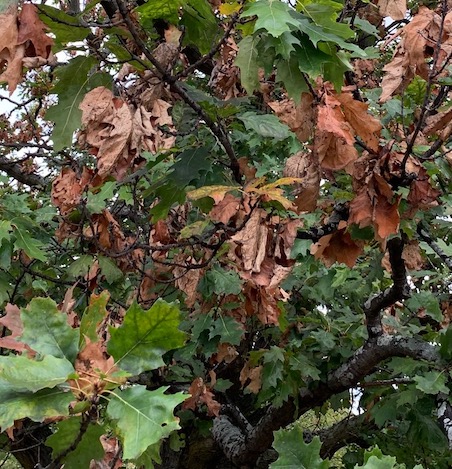
Dieback from Botryosphaeria on red oak
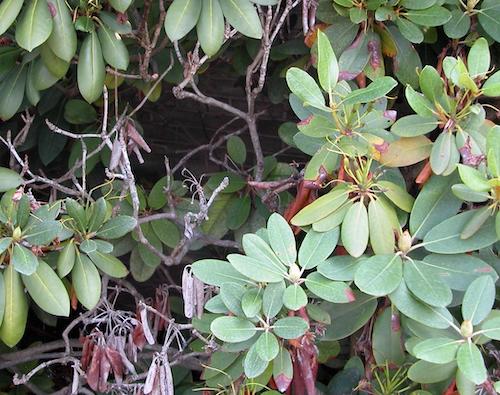
Blackened, sunken, and splitting bark canker on rhododendron
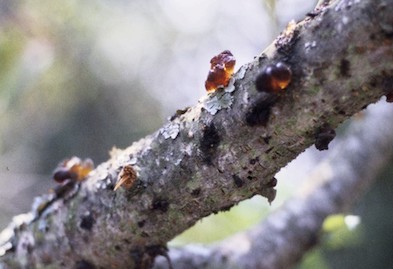
Gummosis on peach branch
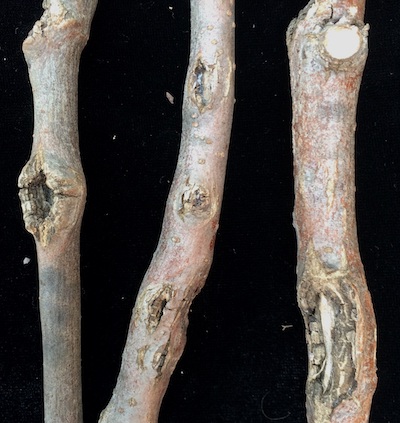
Blisters on tender stems of smooth bark
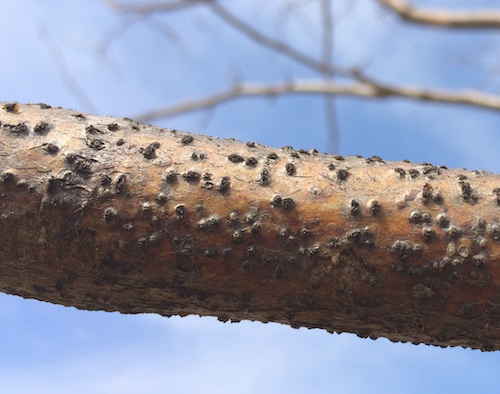
Canker on honeylocust rupturing through the bark
Once infected, there is no chemical response to Botryosphaeria disease.
Virginia Tech scientists recommend pruning out dead wood (using sanitized tools) to at least 6 inches beyond the diseased wood. Scientists urge gardeners to prune in dry weather to limit the fungal spread. Healthy wood looks white to cream-colored when cut. Diseased wood looks brown to reddish-brown instead of white. Gardeners should follow appropriate pruning guidelines to maintain the health of the woody plant and to allow the plant to seal off the cut. This process is called CODIT, the compartmentalization of decay in trees.
Gardeners can work to mitigate some plant stresses.
One way is to select plants appropriate for your Hardiness Zone and select the correct growing location for that plant by paying attention to soil pH, light and water requirements, and then correctly planting and caring for it. When planting woody plants, the structural roots, measured 4 inches from the trunk, should be placed no deeper than 1 to 3 inches below the soil surface. Of note, the roots of a lot of container plants are too deep in their nursery pot. Gardeners should remove the excess soil above the roots when planting in their landscape gardens. Roots in containers often circle the pot. Gardeners should cut away circling roots at the top of the root ball because they will girdle the trunk or stem and strangle the plant. Additionally, spread out roots into surrounding soil to encourage lateral growth away from the root ball. All newly installed plants need 1 inch of water per week to provide moisture to the root ball. Water deeply and infrequently (once per week when there is insufficient rain) to encourage root growth laterally and deeper into the soil.
A second way is to avoid volcano mulching, the practice of mounding mulch next to the trunk. Mulch applied in this way keeps too much moisture on the trunk and invites insects, bacteria and fungal infections to enter the trunk. A better practice is to keep mulch at least 2 inches from the trunk. Lay between 2 to 4 inches on top of the root zone at least 3 feet from the trunk. Virginia Tech indicates mulch applied to the drip line is better to conserve moisture, limit grass competition and protect roots from soil compaction.
A third way gardeners can avoid stressing plants is to practice good sanitation and cultural management. For example, pruning causes wounds that allow entry of the Botryosphaeria fungi, especially pruning during wet weather. Using sanitized pruners and saws can reduce the transfer of the fungi to an uninfected plant. To sanitize pruners and other cutting tools, Virginia Tech recommends always sanitizing pruners between plants by cleaning the cutting blade with 70 percent rubbing alcohol or using another sanitizer. Pruning plants at the correct time of year can limit introducing the fungal spores to another plant.
Woody plants in our gardens represent a long-term investment. The vigilant gardener can take steps to fend off these opportunistic pathogenic fungi.
References
• Botryosphaeria Canker and Dieback of Trees and Shrubs in the Landscape, Elizabeth Bush, Virginia
Cooperative Extension, Publication 450-726
• Botryosphaeria Canker of Shrubs, University of Maryland Extension
• Botryosphaeriaceae as endophytes and latent pathogens of woody plants: diversity, ecology, and
impact. Bernard Slippers and Michael Wingfield, Fungal Biology Reviews, Science Direct
• Botryosphaeria Canker, Nicholas Brazee, University of Massachusetts Extension, Landscape, Nursery
and Urban Forestry Program
• A Guide to Successful Pruning: Pruning Deciduous Trees, Susan French, Bonnie Lee Appleton,
Virginia Cooperative Extension Publication 430-456
• Hand Tool Safety, Virginia Cooperative Extension, BSE-51/BSE-323
• CODIT Explained: How Trees Wall Off Damage, Ann M. Mason, Fairfax Master Gardeners